A film about CFL
This film was made between 2020 and 2023 by Manush John, a former student of CFL. It offers a glimpse into the life and philosophy of the school.
This film was made between 2020 and 2023 by Manush John, a former student of CFL. It offers a glimpse into the life and philosophy of the school.
Series of live webinars to discuss our philosophy of education
In Swahili, Mtoto means Child.
Our bi-annual Mela this school year focused on learning about the lives of children in various parts of the world and in a various parts of Central to South India.
Every year, we journey to places from as close as Coorg in Karnataka to Assam in the East, Kutch in the West and the Eastern Himalaya. It is a time when we engage with people and places and over the years, has been an immense learning about the world around and our own place in it.
This year, we were keen to make a concerted endeavour to make friends with children we may not otherwise meet, to learn about them and from them and to share about ourselves as well. We hoped to broaden our own perspectives and feelings of what is to be a child.
We wondered if in this process of mutual encounter we would see that being a child and the process of childhood has many avatars. We worked in four groups of students and teachers.
We travelled to parts of Bangalore, spending enriching days at several schools. These included the Annaswamy Mudaliar Academy in Fraser town, founded in 1907. Warm sharings happened between young adults. There was song and play.
 We visited children at the Association of People with Disabilities and hosted them at CFL as well. Here too, we were welcomed with grace and warmth. We visited neighbouring Bachenhatii school, where children came together around energetic games. We visited Ananya school, where too, it was a day of getting to know one another through games and craft.
We visited children at the Association of People with Disabilities and hosted them at CFL as well. Here too, we were welcomed with grace and warmth. We visited neighbouring Bachenhatii school, where children came together around energetic games. We visited Ananya school, where too, it was a day of getting to know one another through games and craft.
We reached out to children and adults in select regions of the world and regions of the subcontinent. We explored our own notions of childhood. Our youngest lot (by now called the Lat Bats after their assigned region of Latin America) shared a poster on What is a Child? Amongst the many thoughts shared here, one was: Every Adult has a Child in them.
We began to contact schools who may exchange letters and voice mails and video calls. Excitedly, adults wrote to all manner of contacts and “leads”. We suddenly remembered people we’d known from our past lives, friends in different corners of the world. A soccer coach in Ghana, an ex-student, now engaged in Conservation work in Chile.
Large maps of Latin America, the Middle East, Eastern and Western Africa and the Indian Subcontinent went up in our dining area. Small presentations occurred at assembly. Our middle schoolers shared a short film: A conversation with young friends in Ghana, filmed atop our library tower.
Along with repeated tos and fros of ‘Where do you live?’ and “What are your interests?’ was laughter from the film makers themselves who were thoroughly enjoying the work of being camera people.
We sang De Colores, a Joan Baez rendition in Spanish. We listened to and practiced Tibetan phrases.
And so there was correspondence, between Us and our not so nearby friends. As well as between Us and friends who, we would soon visit in their schools and homes. Handwritten letters and Emails travelled to Chile, Chiapas, Ghana, Kenya, Thailand, Nepal.
As well as to Chattisgarh, Madhya Pradesh, Kutch, Northern and SW Karnataka, Tamil Nadu and Andhra Pradesh. These were precursor to actual “trips”. Our usual yearly excursions happened to people and places we had been in touch with. And already, we were busy preparing for two separate weeks of our Mtoto Mela when children and adults would visit CFL.
We called these two weeks the “Mtoto mela or Children’s Conference”.

The process of conceiving and planning the Mtoto conference was both exciting and demanding. Students formed several committees which took on work in various areas. There was the Kitchen Committee, the Hospitality Committee, the Timetable Committee, the Resource Committee, the Infastructure Committee, the Transport Committee. Overnight, a Parallel Government of sorts arose, able to take on all of the required to run key aspects of not just a conference but of a school itself! Every student was part of a committee and every student took their membership seriously. Being a committee member meant both doing tasks as well as helping to keep an entire group process going. Listening, sharing, imagining, being patient, sorting out differences, learning when to step in and when to invite those who stayed on the edge. Committees adopted teachers as guides. But depending on the work, committee members took on a huge amount of work themselves.

The Conference Weeks had entire townships alive on the CFL campus. And all of the students rose to the occasion of holding the Conference with a warm sense of ownership. There were many spaces to meet children and adults.
Children from other parts of the country brought their stories to CFL. During the conference weeks we had long assemblies, where all gathered and narrated the histories of their schools and the wider stories of their lives.
And now, some recollections and reflections on our Mela theme: Childhoods.
We met children in rural parts of Tamil Nadu, Chattisgarh, Kutch, Madhya Pradesh and Karnataka. We received letters from children as far away as Puerto Guadal in Chile.
Some themes of Childhood spread across the lives of many friends we made.
Childhood is work.
All children work in some way or the other, at home and in school.
Childhood for some means coming home in the evening and gathering firewood for the evening and fodder for your goat. Or looking after the cows that live in the school community: Taking them out to graze, giving them water, milking, washing.
Childhood for many means helping to run a kitchen. Cooking, cleaning, planning, keeping a system going.
Childhood for many means being responsible for younger children.
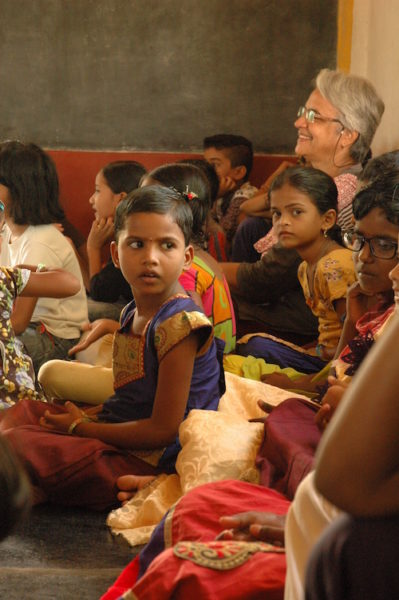 Some of the young adults we met had barely had a childhood. Their lives moved from little formal schooling at all, to leaving school and home and having to earn their own keep young, to now dedicated learning of artisanship (carpentry, masonry): expertise that will bring a livelihood.
Some of the young adults we met had barely had a childhood. Their lives moved from little formal schooling at all, to leaving school and home and having to earn their own keep young, to now dedicated learning of artisanship (carpentry, masonry): expertise that will bring a livelihood.
Childhood for many includes a chance for creative expression, and for some, to truly delve into areas of the arts such as classical music and dance.
We met with an abundance of song and craft and drama. The music, dance and drama told stories of people’s lives.
Some of the children we wrote to make crafts such as bead necklaces and earrings which they take to the local market in their town.
Childhood is play and abandon! From playing marbles and football and Frisbee, children have a great time just playing!
Young people from Central India put the circle of seasons vividly to song:
Jamun fruits falling when the rain comes, a woman off to her khet (field), the child left behind in tears, boys playing the flute and dancing, as they work in fields.
To sing is to tell about your life.
 Childhood means participation in the larger plans of the school, helping to organize, bringing in your ideas. In one instance, young people announced that they wanted more time to study for exams. It was a shift from a earlier school time that allowed more space for spontaneity. They made sure the time table had time to prepare for imminent exams.
Childhood means participation in the larger plans of the school, helping to organize, bringing in your ideas. In one instance, young people announced that they wanted more time to study for exams. It was a shift from a earlier school time that allowed more space for spontaneity. They made sure the time table had time to prepare for imminent exams.
Childhood is a Tapestry of Personalities and Emotions.
We were surrounded and inspired by children who were at once: generous, warm, kind, strong-minded, loving, defenceless, vulnerable, silent, shy, vibrant, smiling, contemplative, articulate, sophisticated, determined, kind, independent, playful and sensitive.
For some, childhood is filled with a longing for a lost homeland. For some, childhood merges seamlessly into adulthood, young members of families and communities taking on the responsibilities of adults.
The Mtoto Mela was incredibly moving in many ways.
We were overwhelmed by the generosity and warmth of communities we stayed with. Our lives are even wider now, with friends we may write to any time, and with a sense of deeper connect with people in pockets of now familiar worlds.
~ Diba
In Kannada, Kallu means Rock. The ancient temple at the edge of Kalluru village, a half an hour walk from CFL, could well have been built from rocks carved out of the nearby landscape. There are large granite outcrops here. Carrying granite to the site would have been easier than having to transport it from far.
We are used to wondering about time in years and dates. But this temple only gives us clues about when it may have been made and the life it may have seen.
Years ago, the oldest village elder, Hanumanarasaiah, told us of how the temple was built in the time of Veera Ballala, a Hoysala ruler. This area was under Hoysala rule around a thousand years ago. A local legend tells of how the temple had a big copper door which disappeared. Ten years ago, our middle school children found similar lotus-like carvings on roofs in Kalluru and a nearby temple complex, the Ranganathaswamy temple. They wondered if the temples could have been built around the same time with similar motifs prevalent? Or did the motifs endure and they were used over a long period? The narasimha, or lion on a Kalluru pillar, resembles the familiar the Hoysala lion.
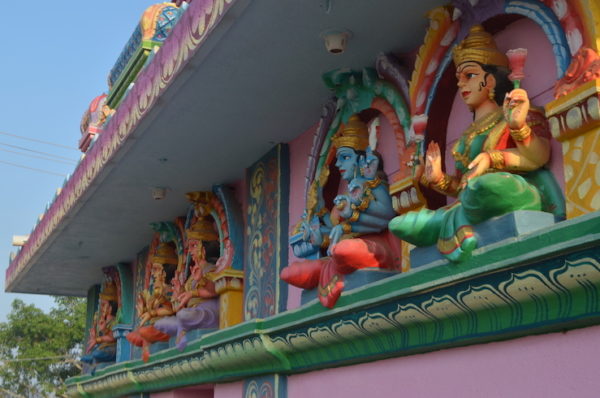
Our ten year-olds found inscriptions along an outer wall panel. Could this be Halle Kannada, Old Kannada?
We wondered. There seemed to be some Tamil letters as well.
A stone structure with a stone roof, housed four pillars with base relief sculptures on all sides.
 Ubba Chitragallu. Children drew some of the images and speculated about whether the sculptures spoke of a life in the past and about who some of the characters may be. They drew a peacock, a lion and a person leaning on a stick with a goat nearby. They drew acrobats with limbs locked in a circular formation.
Ubba Chitragallu. Children drew some of the images and speculated about whether the sculptures spoke of a life in the past and about who some of the characters may be. They drew a peacock, a lion and a person leaning on a stick with a goat nearby. They drew acrobats with limbs locked in a circular formation.
Children encountered these clues and sensed how Time may be sensed through folk memory, images and symbols.
Children have explored the Kalluru temple site over the past eighteen years that we have lived in Magadi taluk. We have walked to Kalluru scores of times. Looking back on early walks, there was a narrow bumpy earthen path. You may meet cows on their way home, a boy on a bicycle, school children walking home barefoot from nearby Bachenhatti, with heavy book bags.
As several middle school children have done, a group of middle schoolers explored the Kalluru temple in July 2018. This was part of a Local History Project. They had visited a few places in the vicinity.
Our attempt was to try and interpret what we had seen and what we had heard.
We looked yet again at the relief sculptures. We made guesses. What does a relief sculpture of a dancing woman suggest? And the figure playing the flute? Does it have anything to say about the sculptor at all? Did sculptors draw on their own imagination or did they just receive designs and images?
We talked about evidence and finding meaning and speculating.
The change in Kalluru temple was well on its way. Around seven years ago, large plaster figures appeared, atop a flat stone entrance. They were painted light yellow.
The change seemed sudden.
The road widened. Still bumpy but wider now. A car could come through comfortably. Some stone carvings lying in the courtyard were cleared away. A metal door with a mesh window covered the closed mantapam.
In July 2018, our Local History middle school team went to Kalluru temple. It was a long time since I had been there. I had glimpsed inside, but what we now encountered was incredible. Not a total transformation, but a dramatic amalgam of the seeming ancient and the seeming present.
Elaborate stucco sculptures perched on the entrance way and other structures. Sculptures painted with all A manner of colours. Extremely intricate art work done by skilled artisans. A juxtaposition of rough granite and smooth plaster. What was made centuries before and what has now arrived, collapsed almost into one.
 The mantapam was open. In place of the earth floor which we used to sweep and which sheltered cows at night was a shining pink granite floor. The temple priest, the pujari, welcomed us in. In our Local History class we had attempted to learn about the stories of places and people. We sat down on the granite floor. The pujari held forth about life in his grandfather’s time. Some of the children wrote notes.
The mantapam was open. In place of the earth floor which we used to sweep and which sheltered cows at night was a shining pink granite floor. The temple priest, the pujari, welcomed us in. In our Local History class we had attempted to learn about the stories of places and people. We sat down on the granite floor. The pujari held forth about life in his grandfather’s time. Some of the children wrote notes.
People extracted oil from the seeds of the ippe mara trees.
The ippe mara trees were grown before the pujari’s grandfather’s time.
People used herbal remedies.
There were fewer illnesses.
Children learned letters by drawing them in the sand.
People cooked in earthen pots.
Children played kabbadi.
They swam in wells.
We listened to the recollections.
Here was oral history, received memories.
One of our children drew a broken sculpture in the courtyard of a seated figure, broken at the waist. Nor torso or head. Only a belly and cross-legged legs. A semblance of cloth visible across the lower part of the body. A clue about clothing at some period.
The most recent group of middle school Local History students made an exciting “discovery” in March 2019. While trying to copy and make rubbings of inscriptions along outer panels of the temple, they poured water over the engraved letters. And the letters magically appeared, much clearer than we had ever seen them! The students went to work copying down strings of text. As they wrote and as we later examined the findings a few observations appeared:
There were Telugu, Tamil and Kannada letters in these inscriptions.
There were a few names which seemed to be the name of a woman and names of places.
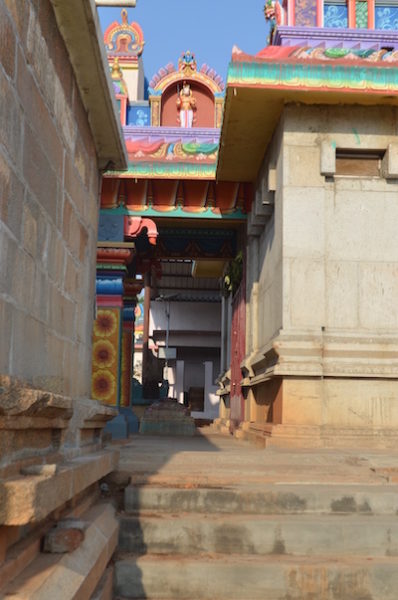 In our discussion, we wondered what this meant. The students suggested that the woman may be connected to the temple in some way, perhaps the priest’s wife? Multiple scripts suggested the presence and interaction of people with varying and connected cultures.
In our discussion, we wondered what this meant. The students suggested that the woman may be connected to the temple in some way, perhaps the priest’s wife? Multiple scripts suggested the presence and interaction of people with varying and connected cultures.
While the eleven year-olds have explored, made drawings and now uncovered inscriptions, a few senior students of Photography and I came to Kalluru with on an early August morning. They were stunned, as I had been, at the transformation.
They had been to Kalluru innumerable times, over their school life. The dizzying splash of colours, the intricately sculpted stuccos caught the eye. But so too a small black granite lotus with incense burning nearby and a pair of dark granite feet sculpted on the ground.
The students, two young women, roamed the site, finding their frames, before bright sunlight shone in.
For our eleven year-olds, stepping into this temple complex for the “first” time, what they see and encounter is a reality that may not alarm. They explore, describe and wonder.
What does such change mean?
Can we even reach for the significance?
Are the meanings we suggest fairly subjective, each of us with our own perceptions?
What does such juxtaposing of the ancient and the modern, an amalgam that may seem alarming to some and celebratory to others mean?
The story of Kalluru, fascinating and mysterious at once, may only become more intriguing as we move into the coming time.
And our children as explorers and story tellers will have more to unravel and more stories to tell.
~ Diba
Leela Garady was an important pillar of support to many founding members of CFL and a deeply inspiring presence. She developed many new and creative ways of teaching language to children. She actively wrote and directed plays in Kannada and Hindi for the students at CFL over the years. Many of her works remain an integral part of the languages curriculum in the school.
Leela passed away peacefully in December 2016. Her insight and knowledge will be missed by all of us.
To read more about her click here.
Nestled as we are in Magadi Taluk on a verdant twenty plus acre campus, it can be hard for us to imagine a world devoid of greenery, fresh air and quiet. As part of our Environmental Management course with the 9th grade children, a colleague and I thought it worthwhile to explore a nearby granite quarry, to experience first hand, some aspects of this form of mining.
As we entered, we were all struck by the assault on our senses. Rubbing their eyes, choking on rock dust the children pointed to the overburden (of waste from the quarry) and greying shrubs (the few that remained) clothed in quarry dust. We had entered a moonscape – hills of rock occasionally clouded by a pall of dust as a delicately balanced earthmover pummeled bundles of stones down the hill in continuous avalanches. Giant drill heads attacked the rock with gusto and trucks carried away stones of different sizes to a processing area. And here, deeper, and further from the main road, the air took on a different quality completely. Our bodies, hair, tongues, nostrils, eyes and ears were sprayed and coated with dust. What was once a magnificent hill, much like that we were so used to climbing on walks from school, now coated us, clung to us, in a completely different form, unrecognisable from its lofty origins.
“How do these workers live here?”, we wondered.
“What kind of lung diseases might they have? What kind of breathing difficulties? Where was their basic safety equipment?”
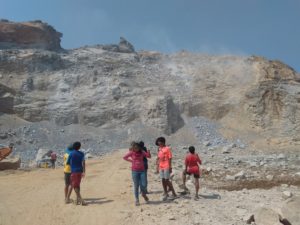 And then of course, a reflection, that this rock dust was a familiar sight in trucks on roads leading to Bangalore, a metropolis less than fifty kilometres away. The same rock dust that builds our houses, our offices, our entertainment and public service venues. It has sadly become an alternative to the fast depleting river sand which has been (illegally, perhaps) mined for decades from the smattering of stream beds in this region.
And then of course, a reflection, that this rock dust was a familiar sight in trucks on roads leading to Bangalore, a metropolis less than fifty kilometres away. The same rock dust that builds our houses, our offices, our entertainment and public service venues. It has sadly become an alternative to the fast depleting river sand which has been (illegally, perhaps) mined for decades from the smattering of stream beds in this region.
Some quarries in this area are said to be in the watershed of the Arkavathi River which emanates from Nandi Hills. This river, dammed at Thippagondanahalli where it meets the Kumudavathi River, was once, and is still occasionally, a source of water to western Bangalore. A source of recharge for bore wells, and water for those along its course.
And so again, we come to core issues in environmental management, whether the context is a big dam, a mine, or a quarry: Who pays? Who benefits? And at what environmental and social cost?
In the month of November 2017, the whole of our village Vardenahalli was gathered on the CFL campus to watch a spectacular Yakshagana performance, Sudarshana Garvabhanga.
Yakshagana is a unique traditional dance form of the Dakshina Kannada district of Karnataka. It is a performing art form where music, dance, dialogue, elaborate make up and costumes come together to weave grand, eloquent stories. Yakshagana performers often choose stories from the Mahabharata, Ramayana and Bhagavat Gita.
Tarakit Kala Kammata, the performing group of the evening, hail from Dakshina Kannada. This group was founded by a former parent of the school, Vani Periodi. The group’s unique feature is that it is an all girls group, with young girls and women performing all the roles. It was a treat to see such youthful energy in the narration of a mythological story, and an added delight to see our former student Indu Periodi performing Lord Vishnu’s role so effortlessly.
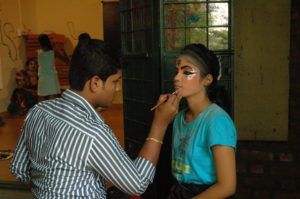 The play Sudarshana Garvabhanga is based on the personified character of Sudarshana Chakra, Vishnu’s weapon – a spinning, disk with serrated edges. The story itself begins with Goddess Lakshmi praising Vishnu, and Sudarshana Chakra feeling hurt and angry that all the credit for defeating the asuras (demons) is going to Vishnu alone. Sudarshana, overwhelmed with an injured ego, wants to show Lakshmi and Vishnu how important and capable he is. He vents all his anger and frustration, claiming boastfully that Vishnu wouldn’t have defeated any asuras without his help. Vishnu, being Vishnu, listens to Sudarshana calmly. Sudarshana Chakra goes away to prove his valour.
The play Sudarshana Garvabhanga is based on the personified character of Sudarshana Chakra, Vishnu’s weapon – a spinning, disk with serrated edges. The story itself begins with Goddess Lakshmi praising Vishnu, and Sudarshana Chakra feeling hurt and angry that all the credit for defeating the asuras (demons) is going to Vishnu alone. Sudarshana, overwhelmed with an injured ego, wants to show Lakshmi and Vishnu how important and capable he is. He vents all his anger and frustration, claiming boastfully that Vishnu wouldn’t have defeated any asuras without his help. Vishnu, being Vishnu, listens to Sudarshana calmly. Sudarshana Chakra goes away to prove his valour.
Meanwhile, the asura Shatruprashudana, who has been blessed with a boon from Lord Shiva, begins to bother all the devas (gods). Shiva’s boon renders Shatruprashudana powerful and almost invincible, a boon that ‘no human or God can kill him, but only a weapon which comes to life may defeat and end his life’.
 Shatruprashudana having menaced all the devas, defeats Indra and takes over Devaloka, the abode of the Gods. Indra comes to Vishnu for help but Vishnu gets defeated by Shatruprashudana. Finally, Sudarshana Chakra kills Shatruprashudana and feels fulfilled in his quest to prove himself worthwhile. He goes to Vishnu to show off but Vishnu reminds him that the victory would not have been possible without the boon. He propounds that one has to emerge victorious over one’s own ego, rather than over anyone else. The play ends with Sudarshana Chakra feeling ashamed about not having seen this truth for himself.
Shatruprashudana having menaced all the devas, defeats Indra and takes over Devaloka, the abode of the Gods. Indra comes to Vishnu for help but Vishnu gets defeated by Shatruprashudana. Finally, Sudarshana Chakra kills Shatruprashudana and feels fulfilled in his quest to prove himself worthwhile. He goes to Vishnu to show off but Vishnu reminds him that the victory would not have been possible without the boon. He propounds that one has to emerge victorious over one’s own ego, rather than over anyone else. The play ends with Sudarshana Chakra feeling ashamed about not having seen this truth for himself.
The performance was mesmerising! No words will be adequate to describe the rapt experience we had that evening.
~ Kavya